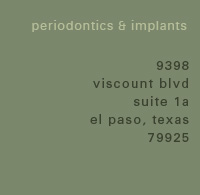- general information
- patient information
- Periodontal Overview
- ––––––––––––––––––––––––––––––––––
- Periodontal Disease and Heart Disease
- Diabetes and Periodontal Diseases
- Periodontal Disease Risk Factors
- Periodontal Complications
- Oral Cancer
- • Biopsy
- Maintaining Periodontal Health throughout a Woman's Lifetime
- Other Diseases and Their Relationship to Periodontal Disease
- Heart Disease: Precautions to be Taken Before Dental Treatment
- Poor Nutrition and Periodontal Disease
- ––––––––––––––––––––––––––––––––––
- What is "Good Oral Hygiene"?
- How to Brush
- How to Floss
- How to Care for Sensitive Teeth
- Hygiene Products
- • Toothbrush Care
- ––––––––––––––––––––––––––––––––––
- New Patient FAQs
- First Visits FAQs
- non-surgical periodontal care
- periodontal therapies
- Traditional Pocket Reduction Therapy
- • Bone Grafting
- ––––––––––––––––––––––––––––––––––
- PerioLase™ LANAP Therapy
- ––––––––––––––––––––––––––––––––––
- Cosmetic Surgery to Improve the Appearance of Your Smile
- • Crown Lengthening to Improve the Esthetics of Your Smile
- • Soft Tissue Grafting to Address Gingival Recession (Root Coverage Grafting)
- Platelet Rich Plasma (PRP)
- Crown Lengthening to Repair a Damaged Tooth
- Exposure / Bracketing of Impacted Tooth
- • Procedure Description for Exposure/Bracketing of Impacted Tooth
- ––––––––––––––––––––––––––––––––––
- Pocket Reduction Surgery FAQs
- Other Therapies FAQs
- dental implants
- Introduction to Dental Implants
- • Single Missing Tooth
- • Two or More Missing Teeth
- • Current Denture User
- • Benefits of Dental Implants
- ––––––––––––––––––––––––––––––––––
- CT Scanner & Comprehensive Implant Planning
- Conscious I.V. Sedation: Is It Right for You?
- ––––––––––––––––––––––––––––––––––
- Socket Preservation Techniques
- Ridge Augmentation and Bone Grafting
- Sinus Graft
- Platelet Rich Plasma
- Routine Implant Maintenance
- our doctors & staff
- office information






Home
Periodontal Therapies
- Traditional Pocket Reduction Therapy
- • Bone Grafting
- PerioLase™ LANAP Therapy
- Cosmetic Surgery to Improve the Appearance of Your Smile
- • Crown Lengthening to Improve the Esthetics of Your Smile
- • Soft Tissue Grafting to Address Gingival Recession (Root Coverage Grafting)
- Platelet Rich Plasma (PRP)
- Crown Lengthening to Repair a Damaged Tooth
- Exposure / Bracketing of Impacted Tooth
- • Procedure Description for Exposure/Bracketing of Impacted Tooth
- Pocket Reduction Surgery FAQs
- Other Therapies FAQs
Procedure Description FOR Exposure / Bracketing of Impacted Tooth
An impacted tooth simply means that it is “stuck” in the bone of your jaw and cannot erupt into function. Patients frequently develop problems with impacted third molar (wisdom) teeth. These teeth get “stuck” in the back of the jaw and can develop painful infections among a host of other problems. Since there is rarely a functional need for wisdom teeth, they are usually extracted if they develop problems. The maxillary cuspid (upper eye tooth) is the second most common tooth to become impacted. The cuspid tooth is a critical tooth in the dental arch and plays an important role in your “bite”. The cuspid teeth are very strong biting teeth and they have the longest roots of all human teeth. They are designed to be the first teeth that touch when your jaws close together so they can guide the rest of the teeth into the proper bite relationship. In other cases, one or more of the anterior fail to erupt in the proper time sequence, requiring intervention by your dentist.
Normally, the maxillary cuspid teeth are the last of the “front” teeth to erupt into place. They usually come in around the age of 11 to13 and cause any space left between the upper teeth to be closed as the teeth are moved together. If a cuspid tooth becomes impacted, every effort is made by dental professionals to help it erupt into its proper position in the dental arch. The techniques involved in aiding eruption can be applied to any impacted tooth in the upper or lower jaw, but most commonly they are applied to the maxillary cuspid (upper cuspids) teeth. 60% of these impacted eye-teeth are located on the palatal side of the dental arch (roof of the mouth). The remaining impacted eye teeth are found in the middle of the supporting bone, but they are stuck in an elevated position above the roots of the adjacent teeth or out to the facial side (outer aspect) of the dental arch.
If the eye tooth is allowed to develop too long in an improper position, the tooth can eventually become fixed in place and it will not erupt by itself, even with the space that orthodontic treatment clears for its eruption. If the patient is older (over 40), there is a much higher chance that the tooth will be fused in position. In these cases the tooth will not budge despite all the efforts of the orthodontist and surgeon to assist its eruption into place. Sadly, the only option at this point is to extract the impacted tooth and consider an alternate treatment to replace it in the dental arch using a crown on a dental implant or a fixed bridge.
Your orthodontist has determined that one or more of your teeth or your child’s teeth are erupting in an improper manner. The orthodontist has referred you to Drs. Caldwell/Dimmitt to complete the surgical portion of care that will be required to gain access to this/these impacted teeth. Surgical access to the impaction site allows the surgeon to attach an orthodontic appliance to the tooth, allowing it to be slowly guided in its proper place in your dental arch. Your orthodontist has already started preparing space for your impacted to move into prior to this appointment. When enough space has been prepared, a surgical procedure will be performed in our office. The gum on top of the impacted tooth will be lifted up to expose the hidden tooth underneath. Once the tooth is exposed, the doctor will bond an orthodontic bracket to the exposed tooth. The bracket will often have a miniature gold chain attached to it and this will be fixed to the orthodontic arch wire for temporary storage. Sometimes the surgeon will leave an exposed portion of the impacted tooth completely uncovered, suturing the gum tissue high above the tooth or by making a window in the gum covering the tooth (on selected cases where the tooth is located on the roof of the mouth). Most of the time, the gum will be returned to its original location where it is sutured in place with only the chain remaining visible as it exits a small hole in the gum. If there is a baby tooth present, it will often be removed at the same time, but the decision about when primary teeth will be extracted will be directed by your orthodontist.
Shortly after surgery (14 - 21 days) the patient will return to the orthodontist where an elastic will be attached to the chain to put a light eruptive pulling force on the impacted tooth. This will begin the process of moving the tooth into its proper place in the dental arch. This is a carefully controlled, slow process that may take up to a full year to complete. Remember, the goal is to assist the eruption process of the impacted tooth, not to extract it! Once the tooth is moved into its final position in the arch, the gum around it will be evaluated to make sure it is healthy enough to last for a lifetime of chewing and tooth brushing. In some circumstances, especially those where the tooth had to be moved a long distance, some minor “tissue grafting or tissue reduction” may be required so the tooth remains healthy during normal function. Dr. Caldwell or your orthodontist will explain this procedure to you if it applies to your specific situation.
These basic principles can be adapted to apply to any impacted tooth in the mouth. It is not that uncommon for both of the maxillary cuspids to be impacted. In these cases the space in the dental arch form will be prepared on both sides at once. When the orthodontist is ready, Dr. Caldwell or Dimmitt will expose and bracket both teeth in the same visit so the patient only has to heal from therapy once. Because the anterior teeth (incisors and cuspids) and the bicuspid teeth are small and have single roots, they are easier to erupt if they are impacted, in comparison to the posterior molar teeth. The molar teeth are much larger teeth and have multiple roots, making them more difficult to move. The orthodontic maneuvers needed to manipulate an impacted molar tooth can be more complicated because of their location in the back of the dental arch.
9398 Viscount Blvd, Suite 1-A | El Paso, TX 79925 | Tel 915-598-6702 | Fax 915-593-7478
Home | General Information | Patient Information | Non-Surgical Periodontal Care | Periodontal Therapies | Dental Implants | Our Doctors & Staff
Contact Us | Referring Doctors | Disclaimer | Sitemap | Periodontic Website Designby PBHS 2012©